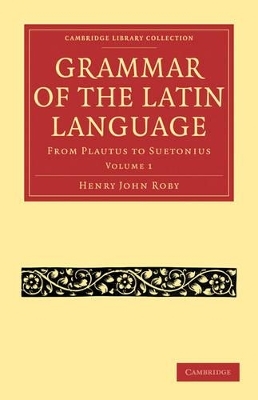
Grammar of the Latin Language 2 Volume Paperback Set
Cambridge University Press
978-1-108-01124-2 (ISBN)
- Keine Verlagsinformationen verfügbar
- Artikel merken
Henry John Roby (1830–1915) was a Cambridge-educated classicist whose influential career included periods as a schoolmaster, professor of Roman law, businessman, educational reformer and Member of Parliament. His two-volume Grammar of the Latin Language, first published in the 1870s, reveals his innovative, descriptive approach to grammar, which situates thorough analysis of the Latin language within the historical context of the writings themselves, or, as Roby puts it, setting 'example above precept' in order to put grammar 'in the proper light, as an account of what men do say, not a theory of what they should say'. The book provides numerous examples from classical Latin writings dating from circa 200 BCE. to 120 CE to illustrate points in phonology, morphology and syntax. A work of remarkable breadth and depth, Roby's book remains an essential resource for both historical linguistics and the study of Latin grammar.
Volume 1: Preface; Book I. Sounds: 1. Elements of speech, and particularly consonants; 2. Combination of consonants; 3. Vowels and combinations of vowels; 4. Laws of phonetic change; 5. Latin alphabet in general; 6. Latin alphabet in detail; 7. Gutturals and palatals; 8. Dentals and linguals; 9. Vowels; 10. Dipthongs; 11. Of Latin words and syllables; 12. Quantity of syllables; 13. Accentuation; Book II. Inflexions: 1. Of inflexions in general; 2. Of noun inflexions, and particularly of gender; 3. Of noun inflexions of number; 4. Of case inflexions in general; 5. Nouns of class I; 6. Old and exceptional forms of cases; 7. Peculiar declensions of certain pronouns and adjectives (Class I); 8. Personal pronouns; 9. Nouns of class II; 10. Nouns of class II cont.; 11. Nouns of class II cont.; 12. Old or exceptional forms of cases (Class II); 13. Greek nouns, class I; 14. Greek nouns, class II; 15. Adverbs and conjunctions; 16. Inflexions of verb; 17. Inflexions of person and number; 18. Inflexions of mood; 19. Classification of inflexions of tense; 20. Tenses formed from the present stem; 21. Of verb stems; 22. Tenses formed from the perfect stem; 23. Of the perfect stem; 24. Of the supine stem; 25. Of the traditional classification of verbs; 26. Examples of the complete inflexions of verbs; 27. Inflexions of the verb sum, and compounds; 28. Inflexions of some irregular verbs; 29. Alphabetical list of deponent verbs; 30. Alphabetical list of verbs, with their perfects, supines, &c.; Book III. Word-formation: 1. Elements of word-formation; 2. Derivative suffixes; 3. Labial noun-stems; 4. Guttural noun-stems; 5. Dental noun-stems; 6. Dental noun-stems cont.; 7. Lingual noun-stems; 8. Lingual noun-stems cont.; 9. Vowel noun-stems; 10. Verb-stems; 11. Composition; 12. Interjections; Appendices; Index. Volume 2: Preface; Book IV. Syntax: 1. Classification of words; 2. Parts of a simple sentence and use of parts of speech; 3. Of the different kinds of sentences; 4. Order of words and sentences; 5. Use of noun inflexions; 6. Use of cases; 7. Use of nominative case; 8. Use of accusative case; 9. Use of dative case; 10. Use of locative and ablative cases; 11. Use of genitive cases; 12. Use of infinitive; 13. Tenses of infinitive, when used; 14. Use of verbal nouns, especially the gerund and gerundive; 15. Use of verb inflexion; 16. Use of verbal inflexions of person and number; 17. Of indicative and imperative moods and their tenses; 18. Of the subjunctive mood and its tenses; 19. Typical examples of subjunctive mood and its tenses; 20. Use of moods in hypothetical and conditional clauses; 21. Use of subjunctive mood to express desire; 22. Use of subjunctive mood to express causation; 23. Use of subjunctive mood to express alien or contingent assertions; 24. Of reported speech; Supplement; Index.
| Erscheint lt. Verlag | 20.5.2010 |
|---|---|
| Reihe/Serie | Cambridge Library Collection - Classics |
| Verlagsort | Cambridge |
| Sprache | englisch |
| Maße | 140 x 216 mm |
| Gewicht | 1620 g |
| Themenwelt | Geisteswissenschaften ► Sprach- / Literaturwissenschaft ► Sprachwissenschaft |
| ISBN-10 | 1-108-01124-1 / 1108011241 |
| ISBN-13 | 978-1-108-01124-2 / 9781108011242 |
| Zustand | Neuware |
| Haben Sie eine Frage zum Produkt? |
aus dem Bereich


